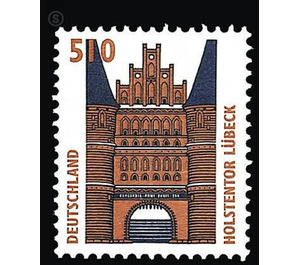Postage stamps: Places of interest - Germany / Federal Republic of Germany 1997 - 510 Pfennig
Theme: Architecture
| Country | Germany / Federal Republic of Germany |
| Issue Date | 1997 |
| Face Value | 510.00 |
| Color | brown white |
| Perforation | K 14 |
| Printing Type | indirect 2-color letterpress |
| Stamp Type | Postage stamp |
| Item Type | Stamp |
| Chronological Issue Number | 1811 |
| Chronological Chapter | GER-BRD |
| SID | 739092 |
| In 29 Wishlists | |
The Holstentor, landmark of the Hanseatic city of Lübeck, is probably the best-known and most important preserved city gate of the late Middle Ages in Germany. It was built between 1464 and 1478 by the Lübeck master builder Hinrich Helmstede. The Holstentor with its walls up to 3.50 m thick has a varied history. It stands on a seven-meter-high pile, under which were about six meters of bog and peat, which were probably now under the pressure of the building to lignite. The gate was set on a beam rust construction, which probably rests on a pile foundation. The ground, however, did not withstand the enormous load and continued to give way over the centuries. Today, the lowest loopholes are sometimes more than half a meter below the surface of the earth. In the 16th century, the construction of a bastion in front of the gate was necessary to strengthen the defense system. The passage of the bastion received a magnificent late-Renaissance presto, which was demolished in 1853 to make room for the age of technology. After many years of discussion about the ruined Holsten Gate, it was completely restored until 1871. The inscription "CONCORDIA DOMI FORIS PAX" - Inside Eintracht, outside peace - has only existed in this form since 1863. It is the shortened version of earlier inscriptions. The letters "S.P.Q.L." located on the city side of Holstentor since 1871 are the abbreviations for the Latin words SENATUS POPULUSQUE LUBECENSIS - Senate and People of Lübeck. (Text: Press and Information Office of the Hanseatic City of Lübeck)


